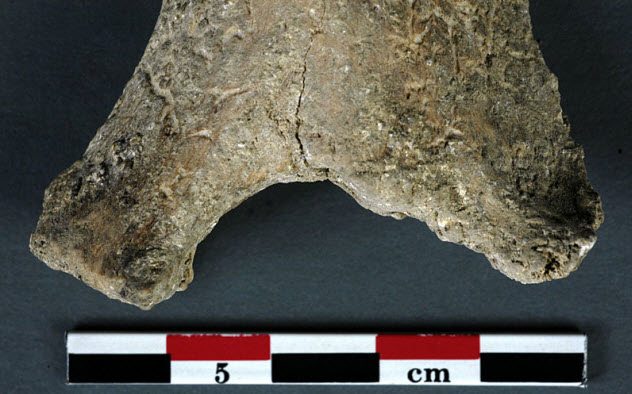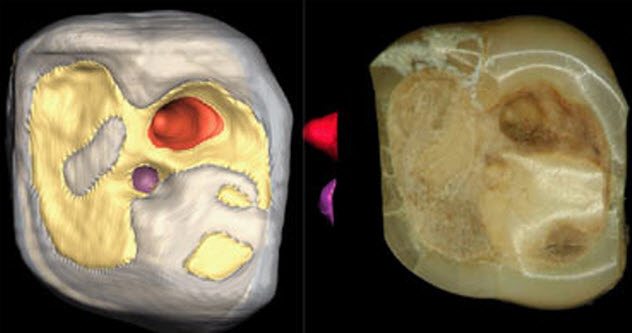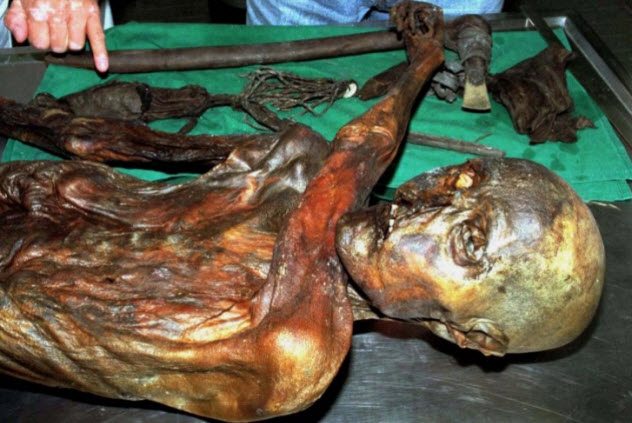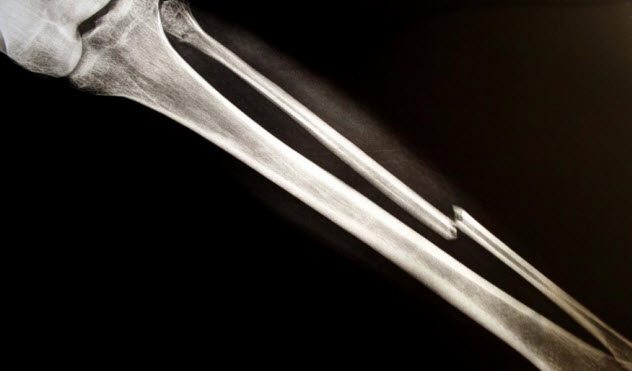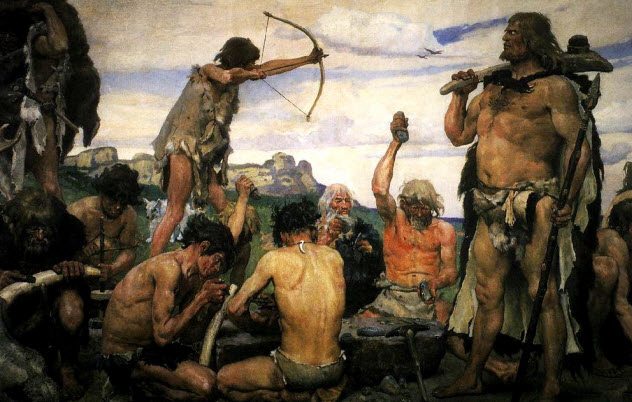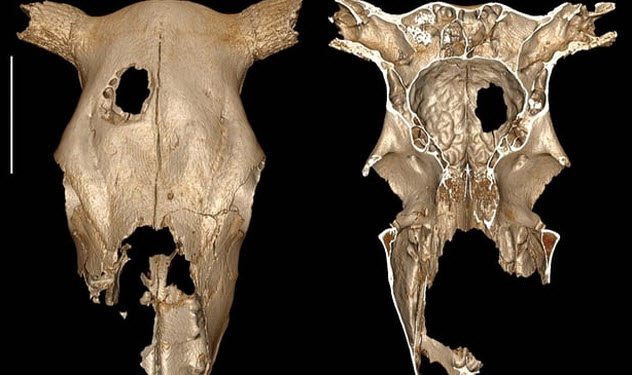Prehistoric cavemen just don’t get many chances to stand up for themselves. Almost all we know about them are what they left in their graves. Even though they didn’t write anything down, though, their bodies let us see what their doctors could do—and some of it is downright incredible.
10 Amputation With Anesthetics
In a field 70 kilometers (43 mi) south of modern-day Paris, a man had his arm amputated. His doctor provided him with an anesthetic, surgically removed his forearm, and treated the wound with an antiseptic. And it happened 7,000 years ago. The process was almost certainly a bit cruder than it would be today. However, based on a Stone Age skeleton found in France, archaeologists believe that a tribal medicine man in 5000 BC was able to pull off every part of that operation. Marks on the skeleton show that its forearm was cut off with the careful precision of a surgeon, albeit working with a tool made of flint. Supplies carried by other bodies suggest that the man was probably given a hallucinogenic drug, likely Datura, to keep the procedure from being too painful to bear. The lack of infection suggests that it was treated with an antiseptic like sage after the amputation was finished. And the healing of his bones indicates that he lived a healthy life for years afterward.[1] It’s hard to imagine a Stone Age medicine man pulling all that off, but they could do it—and it isn’t something that just happened once. Archaeologists have actually seen signs of amputation on multiple Stone Age bodies, and the patients usually appear to have survived the amputation. And it was all done with a sharp piece of a flint and a few plants.
9 Using Ants To Stitch Wounds
If Neolithic doctors could perform surgeries, they had to be able to stitch up those wounds, too. And sure enough, there’s every indication that medicine men have been stitching up wounds since well into the Stone Age. Every place had a unique way of doing it. In Egypt, they used linen. In Europe, they used catgut. But the most interesting technique of all has to be the one done with ants. In India and some parts of Africa, early tribes would stitch up wounds by letting ants crawl onto their patient’s body and bite the wound. As soon as the creature had latched onto two sides of torn skin, the doctor would snap its head off. The ant would die with its mandibles in a death grip, clasping the wound together. It’s believed that this technique has been around since the Neolithic era. It’s hard to say exactly how they were using it then, but by the time writing had come to India, they were already using ants to stitch up perforated intestines.[2]
8 Dentistry With Drills
The oldest dental drill ever found was built a lot earlier than you’d expect. It was made of flint in what we now call Pakistan, and a professional dentist was using it an unbelievable 9,000 years ago. An entire tribe has been found with clear signs of dental work on their teeth. Apparently, an early dentist used a flint drill to bore into the teeth of his tribesmen whenever they complained of toothaches. In one case, he even pulled off a complex tooth enamel removal and cavity wall restoration. The area was full of bead craftsmen, and it’s believed that their expertise in bead art was the key to their almost anachronistic advances in dentistry. The tribe put their bead-carving techniques to use on teeth and developed a whole system for dentistry when they realized it worked.[3] They kept it going for a long time, too. There wasn’t just one dentist in this tribe. In a period before written language, this tribe managed to pass down the knowledge of dentistry for an estimated 1,500 years before their incredible talent was lost.
7 Acupuncture
Based on the marks on a 5,300-year-old mummy found in the mountains between Italy and Austria, Stone Age Europeans started using acupuncture a long, long time ago. In fact, they were using it a good 2,000 years before the Chinese. The mummy, known as Otzi the Iceman, is believed to have suffered from bladder problems and stomachaches while he was alive. He had no way of knowing what was wrong, but a family of whipworms was growing inside his body and almost certainly causing him incredible pain. Somebody in Otzi’s tribe treated him with acupuncture. His back is full of puncture marks from tiny needles that were probably made of stones or bones. His primitive doctor then daubed the wounds with burned herbs, possibly to help keep them clean. The acupuncture wouldn’t have fixed the underlying problem (the whipworms living in his body), but it would have effectively given him some relief from the pain.[4] More than anything, it shows an incredible understanding of medical technique. Somewhere along the line, Otzi’s descendants forgot how to perform the treatment his doctor gave him. Europeans wouldn’t learn how to do it again for nearly 5,000 years.
6 Obstetric Guides
In the Stone Age, childbirth was quite dangerous. Without modern medicine, giving birth to a baby could be fatal. In some places, it’s estimated that about one-third of women died in childbirth. But not everywhere. Some tribes already had a basic idea of how to take care of a woman giving birth. Some archaeologists believe that certain Stone Age tribes had strategies, procedures, and instructions to help a woman give a healthy birth. And, most incredibly of all, they even drew birthing guides on the cave walls.[5] According to some archaeologists, cave drawings have been found that were meant to be a sort of Stone Age version of What to Expect When You’re Expecting. They seem to show a woman giving birth in an upright position with her arms supported above the waist—a position that would have been the best way to deliver a baby as easily and painlessly as possible with the resources available to them. Then, the drawings seem to instruct the woman to lean forward for the second stage of labor. These caves wouldn’t have been their homes. They would have been primitive maternity wards. According to the theory, the expectant mother would have been taken into the cave so that they could easily protect her during childbirth. In that cave, she’d be out of the weather and the smell wouldn’t attract wild animals.
5 Setting Broken Bones
Cavemen had ways of fixing broken bones, too. If a hunter shattered his arm in an accident, early doctors would encase the arm in clay and let it dry out in the sun. It was similar to a modern doctor putting an arm in a plaster cast, and it worked. Not every doctor could do it. Some tribes didn’t have readily available resources to make these clay casts or simply lacked the knowledge. Many Stone Age remains seem to suggest that wounded warriors often just left it up to their bodies to take care of broken bones. Some of the best Stone Age doctors, though, could work wonders with clay casts. After inspecting the healed bone on a Stone Age body, one archaeologist remarked that it was “not inferior to what we should expect from the most skillful surgeons of the globe.”[6]
4 Patching And Disinfecting Wounds
Stone Age doctors had ways of patching up and disinfecting wounds. When a warrior got hurt in battle, there was somebody in the tribe who could make sure they didn’t die of their wounds. It’s a little hard to say how they did it because we’re talking about how they treated flesh and, for the most part, all archaeologists have to work with are bones. However, we know that they had some way of patching up and disinfecting wounds because we’ve found the remains of people who have survived being bashed in the head with clubs and pelted with arrows until they looked like a pin cushion. That would have been impossible without a good doctor. The earliest civilizations, though, give us a little as to what prehistoric doctors did. Ancient Egyptians apparently believed that evil spirits could sneak into an open wound, showing a crude, early understanding of how infections worked. They would patch up the wound with dung, which had antibiotics and proteins that helped their patients heal.[7] Stone Age doctors probably did something similar. Like the Egyptians, they probably thought that they were preventing evil spirits instead of infections. But whatever they did to keep these wounds clean worked.
3 Digestive Aids
During the Age of Exploration when Europeans were making first contact with tribes that were still living with Stone Age technology, they noticed the tribesman doing something that seemed incredibly strange. The tribesmen would treat up the earth and start eating dirt and clay. At the time, Europeans thought this was nothing more than a primitive eating disorder. However, more recent research suggests that these people were doing something our Stone Age ancestors did, too, and that it actually worked. Historians now believe that eating dirt was probably one of the first medical techniques ever used. Studies suggest that the prehistoric tribes would dig out clay, boil it, and eat it to help fight upset stomachs. They would especially do this in places with a lot of foodborne microbes, suggesting that they probably ate the clay to help protect against toxins and settle their upset stomachs. Pregnant women would eat it, too, most likely to help them when they were struggling with nausea and vomiting. It sounds gross, and it probably looks a little weird. But thousands of years ago, a man shoveled a fistful of dirt into his mouth and that’s how medicine began.[8]
2 Medical Training Exercises
These early doctors didn’t always just dive into performing surgery. They took precautions and practiced. Archaeologists have found animal bones from the Neolithic era that have been given surgery. One was a cow skull found in France. Five thousand years ago, somebody carefully drilled a hole in its head with a sharp flint stone. Since it’s highly unlikely that cavemen were so worried about their cattle that they’d perform surgery on them, it’s believed that these animals were primitive practice dummies. It’s believed that Stone Age doctors-in-training would experiment on these animals before trying to treat a friend. Which was probably for the best. The wound on that 5,000-year-old cow head never healed.[9] That means that the doctor screwed up and killed the cow—and his human patient was probably happy that the doctor didn’t try it on him first.
1 Brain Surgery
That Stone Age doctor was trying to perform a procedure called trepanation, an early form of brain surgery. Believe it or not, in the Stone Age, it was incredibly common all around the world—and we’ve been doing it for at least 10,000 years. Early doctors would bore a hole into a patient’s head by scraping it with a flint tool. Then the doctor would scrape out fractured bits of skull in the brain and clean out a pool of blood growing in the head. It actually worked, too. The treatment would help people with head injuries and, more often than not, the patients seem to have survived the procedure. Based on cave paintings, they’d carve these holes into the heads of patients with epilepsy, migraines, and mental disorders. In their time, they probably believed that these patients were possessed by evil spirits, which were released by cutting holes in their skulls.[10] Even if they didn’t understand the cause, though, they pulled it off. Their patients survived—even if they did have to go around with holes in their heads. Read More: Wordpress
